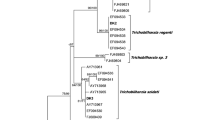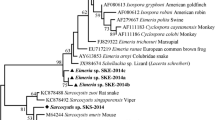Abstract
This study was conducted to investigate the Isosporoid protozoan infections in finch types. Fecal samples were collected from marketed domestic Java sparrows (Lonchura oryzivora), colored and white Zebra finch (Taeniopygia guttata), and European goldfinch (Carduelis carduelis) in southern Iran. The coccidial oocysts were recovered and investigated according to the morphological features and the ribosomal gene markers. Additionally, a challenge infection was conducted with 5 × 104 and 5 × 103 sporulated oocysts in four java sparrows to estimate the clinical manifestations. Based on the morphology, the oocysts of Isospora lunaris were identified in all sampled bird types; however, the molecular method revealed the isolates had considerable similarities with some of Isospora and systemic Isospora-like organisms named as Atoxoplasma. Phylogenetic data also constructed an Atoxoplasma/Isospora clade with high sequence identities. High dose of the challenge with the parasite led to severe depression and sudden death, but it did not coincide with remarkable lesions and parasitic invasion in visceral organs. Contrary to molecular results, this feature is consistent with the common Isospora infections in passerines and differs from those described for Atoxoplasma species. Because of the prevalence, possibility of transmission, and clinical consequences, preventive measures are necessary to avoid outbreaks of isosporoid infections among finch type birds.




Similar content being viewed by others
References
Amoudi MA (1988) Two new species of Isospora from Indonesian birds. J Protozool 35:116–118
Amoudi MA (1994) Four new species of the coccidian parasite Isospora (Apicomplexa, Eimeriidae) from Malayan birds. Zool Stud 33:165–169
Berto BP, Flausino W, McIntosh D, Teixeira-Filho WL, Lopes CW (2011) Coccidia of new world passerine birds (Aves: Passeriformes): a review of Eimeria Schneider, 1875 and Isospora Schneider, 1881 (Apicomplexa: Eimeriidae). Syst Parasitol 80:159–204
Blanc É, Grulet O (1985) Isospora vagoi n. sp. parasite de Poephila guttata (Mandarin d'élevage). Bull Mus Natn Hist Nat Paris 4:401–405
Box ED (1981) Isospora as an extraintestinal parasite of passerine birds. J Protozool 28:241–246
Coelho CD, Berto BP, Neves DM, de Oliveira VM, Flausino W, Lopes CWG (2011) Two new Isospora species from the saffron finch, Sicalis flaveola in Brazil. Acta Parasitol 56:239–244
Cushing TL, Schat KA, States SL, Grodio JL, O’Connell PH, Buckles EL (2011) Characterization of the host response in systemic isosporosis (atoxoplasmosis) in a colony of captive American goldfinches (Spinus tristis) and house sparrows (Passer domesticus). Vet Pathol 48:985–992
Dolnik OV (2006) The relative stability of chronic Isospora sylvianthina (Protozoa: Apicomplexa) infection in blackcaps (Sylvia atricapilla): evaluation of a simplified method of estimating isosporan infection intensity in passerine birds. Parasitol Res 100:155–160
Gosbell MC, Olaogun OM, Luk K, Noormohammadi AH (2020) Investigation of systemic isosporosis outbreaks in an aviary of greenfinch (Carduelis chloris) and goldfinch (Carduelis carduelis) and a possible link with local wild sparrows (Passer domesticus). Aust Vet J 98:338–344
Hall TA (1999) BioEdit: a user-friendly biological sequence alignment editor and analysis program for Windows 95/98/NT. Nucl Acids Symp Ser 41:95–98
Kumar S, Stecher G, Li M, Knyaz C, Tamura K (2018) MEGA X: molecular evolutionary genetics analysis across computing platforms. Mol Biol Evol 35:1547–1549
Levine ND (1982) The genus Atoxoplasma (Protozoa, Apicomplexa). J Parasitol 68:719–723
Liu D, Brice B, Elliot A, Ryan U, Yang R (2019) Isospora coronoideae n. sp.(Apicomplexa: Eimeriidae) from the Australian raven (Corvus coronoides) (Passeriformes: Corvidae) (Linnaeus, 1758) in Western Australia. Parasitol Res 118:2399–2408
Long PL (1993) Avian coccidiosis. In: Kreier JP (ed) Parasitic protozoa. Academic Press Ltd., London, pp 1–88
Luna-Castrejón LP, Ravines-Carrasco L, Salgado-Miranda C, Soriano-Vargas E (2018) The canary Serinus canaria (Passeriformes: Fringillidae) as a new host for Isospora bioccai in Mexico. Int J Parasitol Parasites Wildl 7:445–449
Matsubara R, Fukuda Y, Murakoshi F, Nomura O, Suzuki T, Tada C, Nakai Y (2017) Detection and molecular status of Isospora sp. from the domestic pigeon (Columba livia domestica). Parasitol Int 66(5):588–592
McQuistion TE (1990) Isospora daphnensis n. sp. (Apicomplexa: Eimeriidae) from the medium ground finch (Geospiza fortis) from the Galapagos Islands. J Parasitol 76(1):30–32
Mcquistion TE, Wilson M (1988) Four new species of Isospora from the small tree finch (Camarhynchus parvulus) from the Galapagos Islands. J Protozool 35:98–99
Mcquistion TE, Wilson M (1989) Isospora geospizae, a new coccidian parasite (Apicomplexa: Eimeriidae) from the small ground finch (Geospiza fuliginosa) and the medium ground finch (Geospiza fortis) from the Galapagos Islands. Syst Parasitol 14:141–144
Power ML, Richter C, Emery S, Hufschmid J, Gillings MR (2009) Eimeria trichosuri: phylogenetic position of a marsupial coccidium, based on 18S rDNA sequences. Exp Parasitol 122:165–168
Şaki CE, Özer E (2012) Isospora species (I. canaria, Isospora sp.) in canaries (Serinus canarius, Linnaeus). Turk J Vet Anim Sci 36:197–200
Schoener ER, Alley MR, Howe L, Castro I (2013) Coccidia species in endemic and native New Zealand passerines. Parasitol Res 112:2027–2036
Schrenzel MD, Maalouf GA, Gaffney PM, Tokarz D, Keener LL, McClure D, Griffey S, McAloose D, Rideout BA (2005) Molecular characterization of isosporoid coccidia (Isospora and Atoxoplasma spp.) in passerine birds. J Parasitol 91:635–647
Tokiwa T, Kojima A, Sasaki S, Kubota R, Ike K (2017) Isospora lunaris n. sp. (Apicomplexa: Eimeriidae) from the domestic Java sparrow in Japan. Parasitol Int 66:100–105
Trachta e Silva EA, Literák I, Koudela B (2006) Three new species of Isospora Schneider, 1881 (Apicomplexa: Eimeriidae) from the lesser seed-finch, Oryzoborus angolensis (Passeriformes: Emberizidae) from Brazil. Mem I Oswaldo Cruz 101(5):573–576
Yang R, Fenwick S, Potter A, Elliot A, Power M, Beveridge I, Ryan U (2012) Molecular characterisation of Eimeria species in macropods. Exp Parasitol 132:216–221
Yang R, Brice B, Ryan U (2014) Isospora anthochaerae n. sp. (Apicomplexa: Eimeriidae) from a red wattlebird (Anthochaera carunculata) (Passeriformes: Meliphagidae) in Western Australia. Exp Parasitol 140:1–7
Yang R, Brice B, Ryan U (2016) Morphological and molecular characterization of Isospora neochmiae n. sp. in a captive-bred red-browed finch (Neochmia temporalis) (Latham, 1802). Exp Parasitol 166:181–188
Funding
This study was thankfully supported by a grant from Shiraz University (Grant No. 1/2019).
Author information
Authors and Affiliations
Corresponding author
Ethics declarations
Conflict of interest
The authors declare that they have no conflict of interest.
Ethical approval
Experimental procedures were approved by the Iranian animal ethics committee in Shiraz University Research Council (IACUC, No: 4687/63).
Additional information
Section Editor: Nawal Hijjawi
Publisher’s note
Springer Nature remains neutral with regard to jurisdictional claims in published maps and institutional affiliations.
Rights and permissions
About this article
Cite this article
Rakhshandehroo, E., Fakhrahmad, F., Aliabadi, J. et al. Detection and characterization of the Isospora lunaris infection from different finch hosts in southern Iran. Parasitol Res 120, 257–265 (2021). https://doi.org/10.1007/s00436-020-06962-3
Received:
Accepted:
Published:
Issue Date:
DOI: https://doi.org/10.1007/s00436-020-06962-3




